
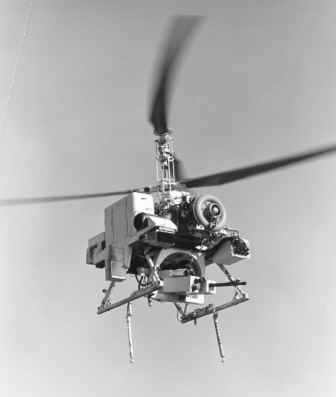 The
reality is that DASH does not exist in the Navy today
and along with that, its advanced Unmanned Aerial Vehicle (UAV) capabilities
that it provided to each destroyer it served on, also does not exist in the Navy
today. The
reality is that DASH does not exist in the Navy today
and along with that, its advanced Unmanned Aerial Vehicle (UAV) capabilities
that it provided to each destroyer it served on, also does not exist in the Navy
today.
The frequently asked question of "Why
is it that an aircraft that was so ahead-of-its-time, then in the 1960s, is not
used by our Navy/military, today" from our public and military
visitors alike needs to be answered and here at the Gyrodyne Helicopter
Historical Foundation (GHHF), we felt that the NAVY
should answer that question.
Accordingly, here is an internal Navy memo, since
declassified, written by Lieutenant Commander Ira B. Anderson USN in 1970 to the
Chief of Naval Operations (CNO) which offers a glimpse of the internal struggle
waged by the Naval Aviators which were frightened at the possibility of being
replaced by Drones and the Drone supporters who were convinced that being freed
of concern over the loss of human life, true expansion of the military
applications of Drones/UAVs could be attained furthering our nations offensive
and defensive capabilities.
In that struggle for control, the Navy failed to support
its' state-of-the-art UAV program (the first of its kind in the world) and
therefore failed DASH.
Please be aware that this internal conflict continues
to this day, with UAV programs consistently being
underfunded to the point of guaranteed failure with
the resulting lessening of the strength of our armed forces.

28 September 1970
From: Lieutenant Commander Ira B. ANDERSON, 633448/1100, USN
To: Chief of Naval Operations
Via: (1) Commanding Officer, U.S. Navy DASH Training Unit
(2) Commander Cruiser-Destroyer Flotilla FOUR
(3) Commander Cruiser-Destroyer Force, U.S. Atlantic Fleet
(4) Commander-in-Chief, U.S. Atlantic Fleet
Subj: Status of QH-50 Drone Helicopter
Ref: (a) LCDR I. B. ANDERSON letter of 9
January 1970
1.
The purpose of this letter is to present a synopsis of the present status of the
Drone Anti-Submarine Helicopter (DASH) weapon system, again focus attention on
the possible additional uses of the QH-50 drone, and submit recommendations
pertinent to the system. As of 22 September 1970, 4,060 manned helicopters had
been lost in Vietnam. It is felt that the following paragraphs contain
information that could be used to reduce the loss of personnel that must have
ensued.
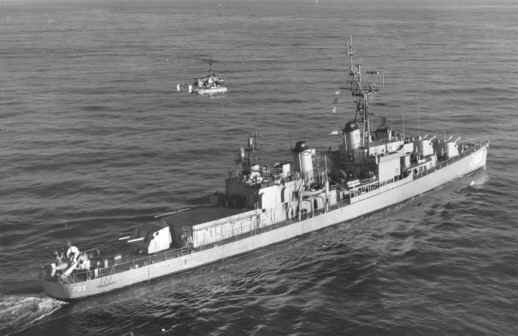 2.
Extensive newspaper and television coverage has recently been given to a report,
attributed to Congressman YATES (Democrat from Illinois) and the Government Accounting Office, which
alluded to the possibility that the system is of no value because of loss of
drones and because the system seems to have been poorly administered at, during
and since its original conception and inception into service. It was also
insinuated that the U. S. Navy was, or has been, guilty of a blunder in the
expenditure of large sums of monies in the perpetration and perpetuation of the
system. No remarks will be made about any of those points except the last. 2.
Extensive newspaper and television coverage has recently been given to a report,
attributed to Congressman YATES (Democrat from Illinois) and the Government Accounting Office, which
alluded to the possibility that the system is of no value because of loss of
drones and because the system seems to have been poorly administered at, during
and since its original conception and inception into service. It was also
insinuated that the U. S. Navy was, or has been, guilty of a blunder in the
expenditure of large sums of monies in the perpetration and perpetuation of the
system. No remarks will be made about any of those points except the last.
3.
The Navy was faced with the responsibility for the safety of the shores of the
country and the freedom of the high seas. It is respectfully submitted that the
originators of the QH-50 drone could foresee that it was one of the means for
fulfilling that responsibility. They (and DASH) cannot be brought to task for
the inabilities of the destroyer to acquire the target. The allegations of the
people, both officer and enlisted (C.O. to plane captain), who have been closely
associated with DASH can be summarized in one statement: "Given
acquisition, we can kill submarines".
4.
“DASH” aside, the QH-50 still exists in inventory. It is a system which has
not been significantly up-dated since its inception but, never-the-less has
capabilities that have never been investigated - - much less exploited. In other
words, no money has been spent and no "Yankee" ingenuity has been
expended except at DASH Training Units to determine whether the drone can be
used in other areas or even to improve its performance as a weapon delivery
system.
5.
Some of the problems that have plagued the QH-50 drone were caused by:
(a) Rapid turnover of experienced people, both officer and enlisted. Naval
Aviation also has such rapid turnover but their people at least remain aviators.
(b) Quickly trained, totally inexperienced officer controllers who have been
used for an average of two years as purely DASH controllers (for which they have
been well qualified) and then have been lost forever to the system.
(c) Lack of training devices. Controllers have been exposed continually to
classroom lectures on emergency procedures but no facilities have existed for
giving training in in-flight emergencies. Reference here is made to an aircraft
simulator such as the ANT-18 or C-11 Link trainer.
(d) No centralized authority. The system has been operated by surface types and
administered by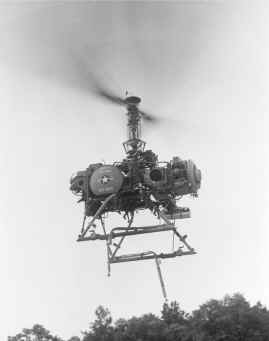 aviators. NAVAIRSYSCOM has been required to fund a system, which
was not under its operational control. COMCRUDESLANT/PAC have been required to
operate a system, which was last in line for aviation money. There have even
been arguments as to whether the drone is an aircraft (hear-say). aviators. NAVAIRSYSCOM has been required to fund a system, which
was not under its operational control. COMCRUDESLANT/PAC have been required to
operate a system, which was last in line for aviation money. There have even
been arguments as to whether the drone is an aircraft (hear-say).
(e) Lack of familiarity with the capabilities/limitations of the system on the
part of people in authority has resulted in limited or improper use of the
drone. Three days at the training command could have made them knowledgeable not
only in tactics but, also in the avionics/mechanics of the system.
(f) PMS (Program Management Systems) has been a bone of major contention and despite the efforts of several
conscientious and talented-people it has remained a problem because a special
system (combination of surface and aviation systems) was originated for the
drone. Refer to last sentence of paragraph 5(d) above.
(g) Poor logistics support as a result of (a) through (f) above.
6.
No single person or command has been responsible for the troubles that have been
encountered with DASH. Contrarily, all the people who have worked with the
system deserve a "well done" because the system has performed beyond
expectations even while suffering with the problems listed.
Needless to say, the
unfavorable publicity given the system has had detrimental effects on the morale
of everyone who has ever been tasked with using the QH-50 drone and in
particular on those who have and do believe that a tremendous potential exists
in droned equipments. Scuttlebutt has suggested that the drone was originally
designed for a lifetime of 25 flight hours. If so, it has exceeded expectations
by some 400 per cent. No official correspondence is available to prove or
disprove these figures. Only a search of files in the cognizant bureau could
produce such correspondence. Cognizance of the DASH problems by personnel
associated with LAMPS could obviate or lessen the impact when, or if, those
problems are encountered in that system.
7.
Reference (a) forwarded information on the QH-50 and recommended that it be
evaluated for possible use in the amphibious environment. Other areas where the
drone might be used to reduce the burden on and minimize losses of manned
aircraft are:
(a) ASMD (Anti-Shipping Mine Detection)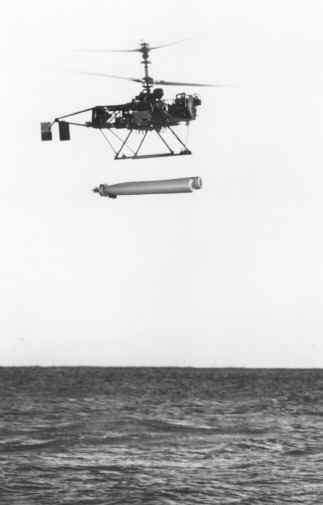
(b) Gunfire Support
(c) Psychological Warfare
(d) Mapping
(e) Delivery of many types of weapons
(f) ECM (Electronic Countermeasures)
(g) ECCM (Electronic Counter-Countermeasures)
(h) UNREP (underway replenishment)
(i) Inshore Undersea Warfare
(j) Mine Laying/sweeping
(k) VERTREP (vertical replenishment)
(l) Sensor Platform
(m) Surveillance/Reconnaissance
(n) Blockade
(o) SAR (Search and Rescue)
(p) Communications Relay
(q) Test and evaluation of other long range
systems
Some of these were mentioned in reference (a) but are repeated to show that
the QH-50 is truly worthy of closer scrutiny.
8. The following area uses that have been made of the system but have
not received general publicity:
(a) A television equipped QH-50 Drone was
used to remotely monitor the project LANPHER underground atomic blast at Mercury
test site in Nevada on 18 October 1967. The drone, controlled from a station 12
miles distant, was flown over ground zero during and after the blast at an
altitude of 1000 feet. The controller had no navigational or tracking equipment
and used an ordinary road map for guidance. It is not known what use was made of
the video tape obtained on that occasion by the Atomic Energy Commission
(AEC) but, it is understood that the AEC personnel were sufficiently
impressed to make an unsuccessful effort to obtain QH-50 drones and a control
station.
(b) In
a test off San Clemente Island, a destroyer was completely hidden for 7 minutes
by a QH-50 Drone-laid smokescreen in 5 knots of wind. This capability could
easily be extended.
9. The Following
recommendations are submitted:
(a)
That administration of the remaining QH-50 assets be centralized under the
cognizance of either CNO (Chief of Naval Operations), CHNAVMAT (Chief of Naval
Material) or COMNAVAIRSYSCOM (Commander, Naval Air Systems Command).
(b)
That full responsibility and authority for those assets be assigned to an
officer of the rank of Captain. He could easily be fully briefed by the
Commanding Officer, U.S. Navy DASH Training Unit and the Aviation Officer on the
staff of COMCRUDESLANT. This Officer should be a member of one of the staffs
mentioned in (a) above (possibly a branch or department head) and should control
the assets through the appropriate logistics organization and the U.S. Navy DASH
Training Unit through its Commanding Officer. Implementation of these
recommendations would eventually eliminate the problems listed in paragraph 5
and allow easy liaison should interest be shown in the areas listed in paragraph
7.
(c)
That this letter be made available to the office responsible for the
administering the LAMPS system.
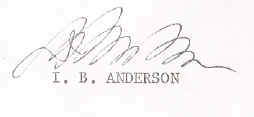

GHHF Final Note: LAMPS stood for Light Airborne Multi-Purpose System
and essentially was a manned helicopter to serve off the then existing DASH
flight decks of the GARCIA class Frigates as well as the larger-decked destroyers
and cruisers replacing the smaller Gearing and Sumner destroyers which DASH had
served on. Naval Aviators will quickly state how
LAMPS was a success, but by the Navy's actions in abandoning their own Unmanned
Aerial Vehicle capability in 1970 ( the most advanced at that time), that led to
a decrease in capability. While the QH-50 DASH was used for a variety of
"suicide-type-missions" like Gun Spotting and flying in heavy weather no manned
aircraft would dare to fly in, resulting in losses, no Navy LAMPS-Manned
aircraft was ever used in such a manner and thus capabilities decreased.
Yet, comparing the QH-50 DASH to any manned helicopter is basically unfair, as
the QH-50 was designed and built as a pure weapons-delivery platform that was
re-usable. While the smallness and the compactness of the coaxial rotor system
would have lended itself nicely to a manned platform, the U.S. Navy did not
pursue that whereas the Russian Navy did and uses their KAMOV Coaxial
Helicopters in all Navy activities. Ask yourself,
"What did the Russian Navy realize, that the Americans did not?"
So,
who was right on the UAV question? Today, the Navy
has NO UAV capability at all and depends on the Air Force for their
reconnaissance and targeting data. While the QH-50 SNOOPY reconnaissance variant
gave EVERY SINGLE destroyer
commander his own, ship-based reconnaissance capability in 1969, today, the U.S.
Navy's destroyer has SH-60B Sea Hawks, manned helicopters whose
capability is not any greater than when they replaced DASH in 1970 with
SH-2D Sea Sprites. It can be argued that while the Naval Aviators
have secured their position back on Destroyer decks during the past 35 years,
the Destroyer as a platform has lost the multi-missionization that the QH-50
system was evolving at the time of DASH cancellation because the basic,
risk-taking missions for the destroyer that the QH-50 performed, are not
performed by any-ship based helicopter.
Another question that
the Gyrodyne Foundation often receives is "Why
doesn't a defense contractor / manufacturer try to field a Vertical Takeoff and
Landing Unmanned Aerial Vehicle today? (VTOL-UAV)". The simple answer is
that DoD contractors make more money from manned-systems than UAVs. Why would
Boeing build a competitor to their AH-64D Apache Helicopter? Why would Sikorsky
build a competitor to their SH-60B series of Navy helicopters? UAVs are
generally cut-rate, disposable systems whereas manned-safe platforms are built
to a much higher standard with multiple redundant safety systems. The QH-50, on
the other hand, didn't even have a feed-back loop for the controller to see if
the helicopter was following his commands.......he had to rely on a radar-return
to see a course change!
With
today's Navy controlled by the concerns of Naval Aviators,
true expansion of what UAV's can bring to the warfighter in the field is now the
purview of the Air Force who fly regular 24-hour long reconnaissance missions
with their RQ-8A Global Hawk UAVs. It should be stated that in 2003, the
Gyrodyne Foundation did participate in a conference conducted by the Naval
Undersea Warfare Center at Newport, R.I. There, GHHF personnel did show that a
Seahawk sized, but not man-safe, QH-50 Advanced Drone could fly for over 24 hrs
and still carry enough reconnaissance, surveillance and targeting systems and
ordnance assets to kill numerous targets and be a force multiplier for any ship
that carried it.....if given the chance. The knowledge has been made
available.....its up to Navy if it wants to continue to be relevant against the
modern threats that face America.
When DASH was shot-down
on a mission or crashed at sea, you ordered
another drone from a Destroyer Tender. When a Sea Hawk crashes today, you have 6
funerals to arrange. That is today's Navy; without any UAV capability, what-so-ever.
We at the GHHF, wished the Navy would evolve, at least to the level of what DASH
provided as an expendable UAV platform, instead of rebuffing what an entire
generation of Navy personnel pioneered and deployed from 1955 to 1970, by not
having anything built upon that past knowledge, for a mission that needs to be
flown again.
For those Navy Pioneers of
long ago, this entire web site is dedicated to, as their contribution to the
defense of the United States of America.

 

|
